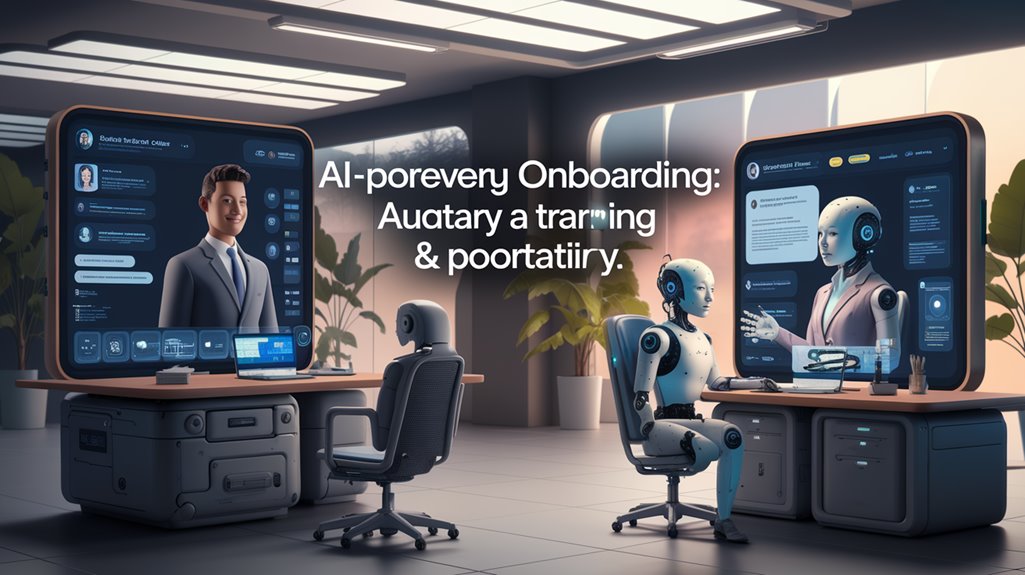AI-Powered Onboarding: Automate Training & Paperwork
AI-powered onboarding tools revolutionize your onboarding process by automating repetitive tasks and crafting personalized training paths. With real-time collaboration and seamless HR system integration, these tools enhance efficiency and regulatory compliance. You’ll experience reduced administrative workload, quicker productivity shifts, and improved engagement. By selecting appropriate AI tools and setting clear goals, you streamline operations and bolster employee satisfaction. To access the full potential of AI in your onboarding strategy, explore further insights and strategies.
Understanding AI in Employee Onboarding
When you explore the world of AI in employee onboarding, it’s clear how transformative this technology can be. AI onboarding tools streamline automated onboarding processes, creating personalized onboarding experiences.
By analyzing new hires’ skills, AI crafts tailored training paths, guaranteeing employee training aligns with individual needs. This approach not only delivers relevant training materials but also enhances efficiency across onboarding journeys.
AI-powered systems automate administrative tasks, providing a seamless onboarding experience that allows HR to focus on strategic roles.
Continuous feedback mechanisms offer insights into new hires’ progress and help address issues promptly, improving retention rates. By reducing errors in payroll and documentation, AI guarantees compliance and accuracy.
Understanding these AI capabilities equips you to optimize onboarding processes effectively.
Benefits of Automating Onboarding Processes
Exploring the transformative potential of AI in employee onboarding naturally leads to examining the numerous benefits of automating these processes. AI-powered onboarding markedly reduces administrative workload, allowing HR to focus on strategic initiatives and boost employee engagement. By automating onboarding, you offer personalized learning paths through tailored training modules, enhancing new hire experiences and improving employee satisfaction. Seamless integration of compliance tasks guarantees 100% regulatory adherence, minimizing errors and legal risks. Furthermore, automation accelerates the time it takes for employees to reach full productivity, fostering smoother role shifts.
| Benefit | Impact | Keyword Application |
|---|---|---|
| Reduced Administrative Workload | Up to 50% reduction | Automate onboarding |
| Personalized Learning Paths | Higher job satisfaction | Training modules |
| Compliance Assurance | 100% regulatory adherence | Compliance tasks |
| Faster Productivity | 30% quicker shift | Seamless integration |
| Enhanced Engagement | 25% improvement | New hire experience |
Key Features of AI-Powered Onboarding Tools
AI-powered onboarding tools exhibit several key features that revolutionize the onboarding process. They automate repetitive tasks like document collection and e-signatures, freeing up HR resources for more strategic initiatives.
Customizable workflows allow you to tailor the process to meet specific organizational needs, enhancing the onboarding experience for new hires.
- Real-time collaboration: Engage instantly with new employees, providing immediate access to resources and support.
- Integration capabilities: Facilitate seamless data transfer with existing HR systems, avoiding duplication of effort and guaranteeing smooth changes.
- Analytics functionalities: Gain insights into employee progress and engagement, allowing for data-driven refinements to your training and onboarding processes.
Steps to Implement AI in Onboarding
To effectively implement AI in onboarding, start by conducting a thorough evaluation of your current process to pinpoint inefficiencies and areas ripe for enhancement. Set clear goals for an AI-enhanced onboarding experience, prioritizing personalized training and efficient paperwork automation. Research and select AI tools, like Waybook, that align with your organization’s culture and needs. Implement gradually, initiating a pilot program to gather feedback from new hires and HR, fostering continuous improvement. Monitor real-time insights to assess process effectiveness, optimizing the employee experience and ensuring compliance.
| Step | Action | Focus Area |
|---|---|---|
| 1. Evaluation | Identify inefficiencies | Process Improvement |
| 2. Goal Setting | Define objectives | Personalization |
| 3. Tool Selection | Choose suitable AI tools | Customization |
| 4. Implementation | Launch pilot program | Feedback & Adjustment |
| 5. Monitoring | Analyze insights | Compliance Optimization |
Overcoming Challenges in AI-Driven Onboarding
Having established a roadmap for effectively implementing AI in onboarding, it’s important to address the challenges that might arise during this transformation.
Integration issues can complicate the seamless connection between AI tools and existing HR systems, impacting the automated onboarding process.
Training HR teams is vital to overcome the learning curve and guarantee they harness the full potential of AI tools.
Privacy concerns regarding employee information require stringent compliance regulations to safeguard sensitive data.
Consider these emotional triggers:
- Frustration: Struggling with integration issues might hinder progress.
- Concern: Balancing technology effectiveness with personalized support is essential.
- Urgency: Addressing privacy concerns guarantees protection of employee information.
Regular evaluations of technology effectiveness will optimize AI tools, aligning them with evolving organizational needs and employee expectations.
Conclusion
By embracing AI-powered onboarding, you streamline training and paperwork, enhancing efficiency and employee satisfaction. You gain precise control over processes, ensuring consistency and compliance. As you implement AI, focus on key features that align with your needs, and address potential challenges proactively. With analytical thinking and technical expertise, you can transform onboarding into a seamless, automated experience, ultimately boosting productivity and fostering a positive first impression for new hires.
